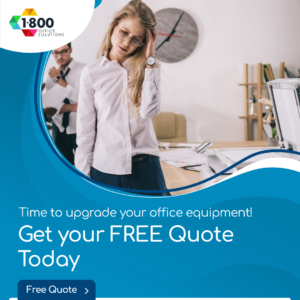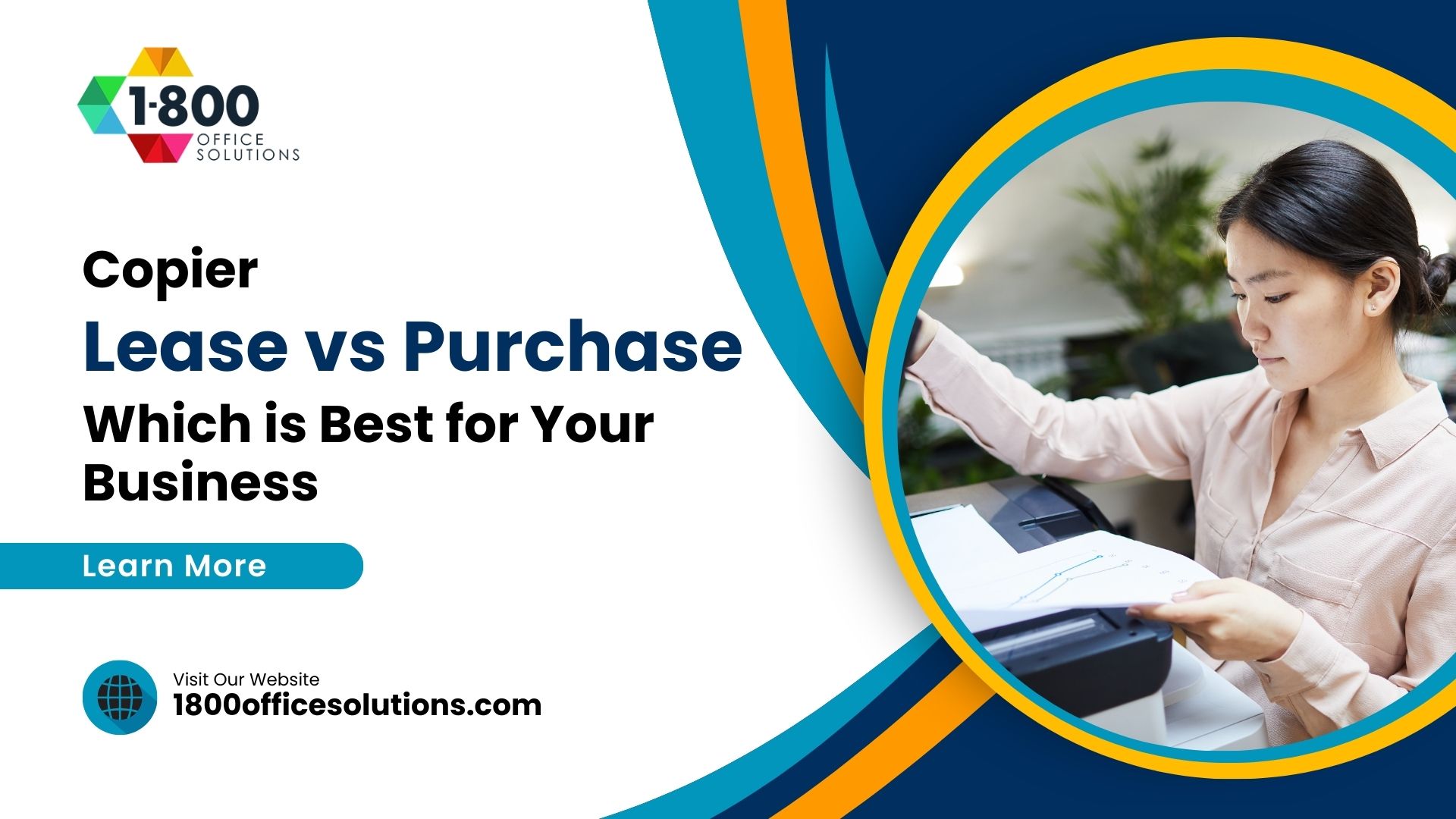Photocopier Costs Out of Control? Discover the Secret to Saving Money Now!
Introduction
In today’s fast-paced business environment, the photocopier has become an essential tool. From copying essential documents to printing marketing materials, the photocopier serves various functions. However, the costs associated with owning and maintaining a photocopier can quickly spiral out of control if not managed properly.
Understanding photocopier costs is not just about the initial purchase price; it encompasses a wide range of hidden and unexpected expenses that can impact a company’s bottom line. The importance of controlling these costs cannot be overstated, as it directly affects profitability and efficiency.
Understanding Photocopier Costs that can provide insights into making informed decisions, whether to buy or lease, and selecting the right commercial copier for your business needs.
The True Costs of Owning a Photocopier
- Initial Purchase Price: The upfront cost of a copier machine can vary widely based on features, brand, and capacity. Whether it’s a simple office copier or a high-end commercial copier, the initial investment might cost anywhere from a few hundred to several thousand dollars.
- Maintenance and Repair Costs: Regular maintenance is essential to keep the copier running smoothly. This includes cleaning, servicing, and repairing parts. Depending on the print volume and usage, maintenance costs can add up quickly.
- Toner and Supply Expenses: Consumables like toner, paper trays, and other supplies are recurring expenses. The cost around these items depends on the print speed, pages per minute, and quality of the materials used.
- Lack of Technology Upgrades: Technology is ever-changing, and an outdated copier can become a liability. Upgrading to a new model with better print speed and pages per month capacity can be costly but necessary to meet evolving business demands.
- Copier Removal and Disposal: At the end of its life, disposing of a commercial copy machine responsibly involves costs. This includes ensuring data security and adhering to environmental regulations.
Hidden Costs of Purchasing a Copier
- Maintenance Agreements: While essential for the upkeep of your office copy machine, maintenance agreements are an additional cost. They cover repair services and parts but can vary in price based on the service provider and copier model.
- Supplies Management: Managing supplies like toner and paper can be a hidden cost. Falling for low-quality products or scams can lead to damage to the machine and additional service calls.
- Technology Upgrades: Upgrading your copier machine to keep up with technological advancements can be expensive. However, it’s essential to maintain efficiency and meet the growing print volume and pages per month requirements.
- Copier Removal and Data Security: Proper disposal of the copier involves wiping its hard drive to protect data. This process, if not handled correctly, can lead to security breaches and additional costs.
10 Commonly Overlooked Printer Fees
1. Printer Maintenance Fees
Regular maintenance of the printer ensures smooth operation, prolonging its lifespan and maintaining print quality. Without a maintenance plan, service technicians might cost over $100 an hour, and the fees can increase each year by as much as 10 percent.
This includes routine inspections, cleaning, and replacement of worn parts. Investing in a maintenance contract might seem like an additional cost, but it can save money in the long run by preventing major breakdowns and ensuring optimal performance.
2. Printer Lease Document Fee
If you choose to lease the printer, a one-time lease document fee, usually around $100, may apply. This fee is billed on the first invoice from your vendor and covers the administrative costs associated with preparing and processing the lease agreement.
While it might seem insignificant compared to the overall cost of the lease, it’s an often-overlooked expense that should be factored into the total cost of leasing. Understanding all the associated fees upfront helps in making an informed decision and negotiating better terms.
3. Printer Insurance Fee
Insurance for the printer covers natural disasters, theft, and accidental damage. It varies based on the machine’s value, location, and coverage level. For a $15,000 multifunction printer, the monthly insurance payment could be around $15.
Insurance provides peace of mind, knowing that your investment is protected against unforeseen events. It’s essential to understand what the insurance covers and compare different policies to find the one that best suits your needs and budget.
4. Printer Property Taxes
Even if you’re a tax-exempt business, property taxes may apply if you’re leasing a printer. The tax can fluctuate depending on the state and may be included in the overall leasing rate. Property taxes are based on the assessed value of the equipment and can be a hidden cost that surprises many lessees.
It’s advisable to discuss property taxes with the leasing company upfront and understand how they are calculated and billed. This clarity helps in budgeting and ensures there are no unexpected costs down the line.
5. Shipping Fee for Printing Supplies and Parts
Automatic shipments of toners and supplies might include a hidden shipping fee. Though typically not substantial, it’s an often-overlooked cost that can add up over time. Shipping fees depend on the supplier, location, and frequency of orders.
Some suppliers offer free shipping for bulk orders or as part of a membership program. Being aware of shipping costs and exploring options to minimize or eliminate them can lead to savings. Negotiating with suppliers or planning bulk purchases are strategies to consider.
6. Printer Training Fee
Training on how to use the new printer might cost extra. Follow-up training for new employees can range from $50-$1000, depending on the machine type and complexity. Training ensures that staff can use the printer efficiently, reducing errors and wastage.
While some vendors offer free initial training, additional sessions or specialized training might be chargeable. Understanding the training needs of your team and negotiating training as part of the purchase or lease agreement can save costs.
7. Not Canceling Your Print Contract on Time
Failure to cancel the lease on time can lead to automatic extensions and extra payments. Understanding the terms and conditions of your contract is crucial to avoid this fee. Lease agreements often require notice several months before the end of the term.
Missing this window can lead to automatic renewal, sometimes at less favorable terms. Keeping track of lease end dates and providing timely notice prevents unnecessary costs and allows for renegotiation or termination as needed.
8. Early Termination Fee
Canceling the lease before expiration might incur a termination fee in addition to the remaining amount on the lease agreement. Early termination fees can be substantial, sometimes equal to the remaining lease payments.
Businesses considering early termination should weigh the costs and benefits and explore options with the leasing company. Negotiating early termination provisions upfront provides flexibility and clarity on potential costs.
9. Printer Upgrades
Upgrades and additional accessories like extra paper trays or a stand might be pricier than expected. A paper tray might cost around $300, and a printer stand around $250. Upgrades enhance functionality but come at a cost.
Understanding the needs of your business and selecting a printer with the right features and accessories from the start can save money. If upgrades are anticipated, discussing them with the vendor upfront and negotiating package deals can lead to savings.
10. Returning Your Printer at the End of Lease
Shipping the printer back to the leasing company, especially if out of state, could be pricey. Some providers recommend including the return fee at the start of the contract. Return fees cover shipping, packaging, and handling and can vary based on the size and weight of the equipment.
Understanding the return process, associated costs, and responsibilities helps in planning and budgeting. Negotiating return fees or exploring local return options can minimize this expense.
Understanding the true costs of owning or leasing a copier or printer goes beyond the initial price tag. From maintenance to unexpected fees, the financial implications can be significant. By being aware of these costs and making informed decisions, businesses can control expenses and choose the right office copy machine that aligns with their needs and budget.
The Ultimate Guide to Xerox Machines provides further insights into selecting the right xerox, ricoh, or other brands to meet your office space and copy and print requirements. Whether it’s copies per day or fax capabilities, understanding these costs is vital for every business.
Discover the Secret to Saving Money from Photocopier Costs
How to Save Money Using Your Office Copier
The office copier is a vital piece of equipment, but it doesn’t have to be a drain on resources. By understanding the office copier machine costs and implementing smart strategies, you can significantly reduce expenses.
- Efficient Usage: Knowing the volume and cost of each copy or print job helps in utilizing the copier efficiently. Selecting the right commercial copier based on copies per month and using features like duplex printing can save both paper and energy.
- Regular Maintenance: Scheduled maintenance minimizes unexpected maintenance costs. Cleaning and servicing the copier regularly ensures it runs smoothly, reducing the need for costly repairs.
- Smart Purchasing Decisions: Whether you buy a commercial copier or choose to rent or lease, understanding commercial copier prices and the total cost of ownership helps in making informed decisions. Opting for a used copier or negotiating the lease agreement can also lead to savings.
Top 5 Ways Your Copy Machine Saves You Money
- Energy Efficiency: Modern copy machines come with energy-saving features. Selecting an energy-efficient model reduces electricity consumption, contributing to lower utility bills.
- Multifunction Capabilities: A multifunction copier that combines printing, scanning, and fax machine functions in one machine eliminates the need for multiple devices. This not only saves space in a small office but also reduces the overall cost of ownership.
- Volume Discounts: Buying supplies in bulk or negotiating copier price based on printing volume can lead to volume discounts. Knowing how much you will pay per month on the low end helps in budgeting and negotiating better deals.
- Managed Print Services: Outsourcing print management can lead to savings. Managed print services take care of maintenance, supplies, and optimization, often at a lower cost than handling these aspects in-house.
- Technology Integration: Integrating the copier with existing office equipment and software streamlines operations. This integration enhances efficiency and can lead to cost savings in the long run.
Leasing vs. Purchasing: What’s Best for Your Business?
- Pros and Cons of Leasing:
- Pros: Leasing a copier allows for regular upgrades, often includes maintenance, and doesn’t require a large upfront investment. Commercial copiers also offer flexibility in terms of contract terms.
- Cons: Over time, leasing a copier might end up costing more than purchasing. There may also be fees associated with the end of the lease or penalties for exceeding the agreed copies per month.
- Pros and Cons of Purchasing:
- Pros: Purchasing a copier means full ownership, no ongoing monthly payments, and potential tax benefits. You have complete control over the copier and how you use the copier.
- Cons: The initial cost can be high, especially for higher-grade commercial copiers reaching into the thousands. Maintenance and upgrades are the owner’s responsibility.
- Making the Right Decision for Your Business: Understanding your business’s specific needs, type of machine, way in determining which machine, and evaluating both buy a copier and decide to lease options will guide you to the ideal copier. Factors such as measured in pages per minute, measured in dots per inch, and whether a good home copy machine might suffice should be considered.
What People Also Ask
Hidden costs include maintenance agreements, unexpected repairs, supply management, technology upgrades, and disposal costs. Understanding these hidden costs helps in budgeting and avoiding surprises.
How can I save money on photocopier maintenance?
Regular maintenance, using quality supplies, and having a clear understanding of the maintenance agreement can lead to savings. Negotiating the terms and being proactive in servicing can further reduce costs.
Is it better to lease or purchase a photocopier?
The decision to lease or purchase depends on factors like budget, need for technological upgrades, and business size. Leasing offers flexibility, while purchasing provides ownership and control. Analyzing the total cost of ownership and your specific needs will guide the decision.
How can I avoid unexpected photocopier fees?
Reading and understanding the lease or purchase agreement, being aware of the maintenance terms, and monitoring usage can help avoid unexpected fees. Transparency with the supplier and regular monitoring ensures that you are not caught off guard.
Conclusion
The world of commercial copy machines is complex, with a wide range of options and costs. From understanding the average office copier to selecting the best office copier or best commercial copier brands, the journey is filled with decisions.
Whether you opt for standard commercial copy machines or explore higher-grade commercial copier machine costs, the focus should be on aligning with your business needs. The Ultimate Guide to Xerox Machines can be a valuable resource in this journey. By embracing energy efficiency, smart purchasing, and regular maintenance, you can take control of copier costs.
The cost of printing doesn’t have to be a burden; with informed decisions and proactive management, you can turn your copier into an asset rather than a liability. Whether you get a copier for a large corporation or a really good home copy machine, the principles remain the same. The copier you choose can be a tool for success, not a financial drain. The power to control costs and make the most of your investment is in your hands.












